|
|
Mumtaz Mahal

|
|
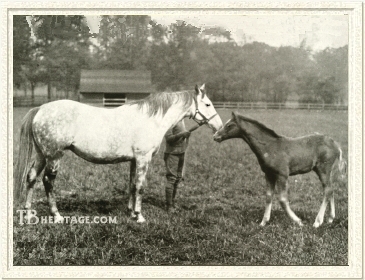 |
|
|
Mumtaz Mahal was dubbed "the Flying Filly" after this daughter of The Tetrarch proved herself one of the fastest two-year-olds ever. An early purchase for the Aga Khan, she also became one of his most important foundation mares. Her descendants, which include Mahmoud, Nasrullah, Royal Charger, Abernant, Petite Etoile, and Shergar, spread her influence around the world, making her one of the most important broodmares of the 20th Century.
|
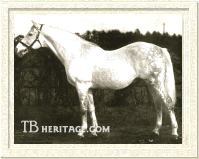
The Tetrarch as an old stallion
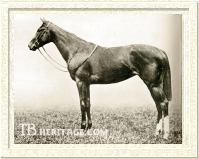
Lady Josephine in racing trim
| |
Bred at Sledmere Stud in Yorkshire by Lady Sykes, Mumtaz Mahal was bred at the height of her sire's popularity as a sire. One of the greatest two-year-olds of all time, The Tetrarch (1911) broke down before he could prove his ability at the classic distances, but was off to a great start at stud. His first crop produced the outstanding two-year-old Stefan the Great. With his first crop just three-year-olds in 1919, he topped the Leading Sires List, led by his champion two-year-old, Tetratema, and helped by his daughter Snow Maiden, winner of that year's Irish Oaks. The next year, The Tetrarch was third on the sires' list, with classic winners Tetratema (2,000 Guineas) and Caligula (St. Leger).
In all, The Tetrarch sired five classicists, including three St. Leger winners (Caligula, Polemarch, Salmon-Trout), but it was through his speedy offspring Tetratema and Mumtaz Mahal that his name lives on.
When Lady Sykes sent her mare Lady Josephine (1912 by the top sprinter Sundridge) to The Tetrarch in 1920, she was breeding at the peak of fashionability. Lady Josephine was a very fast filly herself, the second rated filly of her year at two, and winner of the Coventry Stakes and Acorn Stakes. Lady Josephine's first foal had been the good staying filly Lady Juror (1919 by Son-In-Law), who had won the Jockey Club Stakes in 1921. Lady Juror would produce Fair Trial, The Black Abbot, The Recorder, and become the granddam of the mighty Tudor Minstrel, but that was for the future.
|
Lady Josephine's dam was the Fern Hill Stakes winner Americus Girl, by the American sprinter Americus (nee Rey del Caredes). This was a family dominant for sprinting speed, that remained so for generations.
Sledmere Stud, near Driffield in East Yorkshire, had been a thoroughbred stud since the mid-1800s and already produced the outstanding winners Grey Momus, Doncaster, Spearmint, Mimi, Disraeli, and Lecturer, as well as John O'Gaunt, Hapsburg, and Lemonora. But Sledmere was not past its prime as a stud as yet. The 1920 crop of yearlings included Lady Juror and Teresina, while the 1921 fillies offered for sale included Mumtaz Mahal, and future Oaks winner Straitlace.
The Lady Josephine filly by The Tetrarch was a grey marked with her sire's odd white spots, as well as a large, enlongated star on her face. She was not only a hot commodity pedigree-wise, but also a spectacular individual and when she was offered at the Doncaster Yearling sales in 1922, it took a lot to get her. The buyer, George Lambton, was acting on behalf of the Aga Khan, who was investing heavily in his new past time, and paid 9,100 guineas for her. This price was almost a new record, second only to the 10,000 guineas paid for the yearling filly Sceptre in 1900. At the time of her sale, the BBR noted "As an individual, she is wonderful, as near perfection as imagination can conceive. Her conformation is ideal and she has both size and quality."
The Aga Khan also purchased the colt Diophon at the same sale, but passed on Straitlace, who would later win the Oaks.
The Aga Khan, third to hold that title, and Imam, or supreme leader, of the Ismaili sect of the Shia Muslims, was born Prince Sultan Mohammed in 1877 in India, of a Persian mother. He indulged a family interest in horse racing, and being a great Anglophile, decided to enter English racing with a passion in the early 1920s. He purchased his first horses in 1921 with the aid of George Lambton, and made an immediate splash. These included the yearling fillies Sapience, Paola, Bombay Duck, Cos, Teresina, and Voleuse. Cos became a champion, Paola and Teresina were high class; Cos and Teresina became important broodmares.
The next year, the Aga Khan purchased more yearlings, such as Friar's Daughter, Diophon, and Mumtaz Mahal. Later purchases included Qurrat-Al-Ain, and the colt Blenheim II. As a breeder, his record was phenomenal. Cos produced Rustom Pasha, Mrs. Rustom,and Costaki Pasha; Teresina produced Theresina and Alibhai; Voleuse produced Bala Hissar and Theft. Friar's Daughter produced Triple Crown winner Bahram and his half-brother Dastur. Qurrat-Al-Ain was the dam of Majideh and Queen of Shiraz. Mumtaz Mahal produced a tribe that is still churning out top class horses to this day, a stud program still being carried on by Prince Sultan Mohammed's grandson, the fourth Aga Khan, son of Prince Aly Khan.
The filly he had purchased at Doncaster in 1922, by The Tetrarch - Lady Josephine, was named Mumtaz Mahal, after the wife of the Mogul ruler Shah Jehan, and who is interred, with her husband, in the beautiful mausoleum, the Taj Mahal, in India. Mumtaz Mahal was sent to trainer Richard C. "Dick" Dawson, at Whatcombe Stables, in Berkshire and proved nearly as precocious as her sire, and just as memorable.
Mumtaz Mahal on the Turf
Tried on April 7 against two-year-old stablemate Friar's Daughter, already a winner that season, Mumtaz Mahal humiliated the more experienced filly while conceding reportedly 28 pounds in the saddle. The performance astonished her trainer, and word quickly spread about the phenom at Whatcombe. Mumtaz Mahal made her first of six starts that season on May 16 at Newmarket in the Spring Stakes. Ridden by George Hulme, she broke quickly and raced the field off its feet, leading all the way to win by three lengths in a canter, with the good filly Straitlace in second. The time was a new course record for five furlongs, :57 4/5.
|
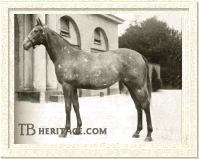
Mumtaz Mahal as a race filly
| |
Moving on to Royal Ascot, she won the five furlong Queen Mary Stakes, coasting home by ten lengths. It was here that Mumtaz Mahal earned her sobriquet "The Flying Filly" and deservedly so. Next came the National Breeders Produce Stakes at Sandown, also at five furlongs, which she won by four lengths. At Goodwood, she won the Molecomb Stakes (five furlongs) but another awesome ten lengths. Stepped up to six furlongs in the Champagne Stakes at Doncaster, she won by three lengths. In her final start of the year, in the Imperial Produce Stakes (Kempton) on October 12, she was clearly not at her best, barely handled the deep going and bravely lost the six furlong test by half a length to the colt Arcade, feeling the whip for the first time.
|
At the end of the season, the handicapper ignored her last start and gave her the high-weight status on the Free Handicap, two pounds over the colt Diphon (her stablemate). Racegoers were certain that they had seen one of the best two-year-olds of all time, certainly one of the best fillies ever.
"Mumty" wintered at Highclere and returned to Whatcombe a bigger, stronger filly than last year's model. She had a remarkable reputation to maintain, and boldly debuted in the 1,000 Guineas. Flying off to a six lengths lead at one point, the extra distance took its toll and she lost at the wire to the fast closing filly Plack by a length and a half, although bravely holding off Straitlace half a length behind in third. After an unplaced performance (fifth of seven) in the mile Coronation Stakes at Royal Ascot, won by Straitlace, her connections returned her to sprinting, and she won the King George Stakes (Goodwood, six furlongs), and Nunthorpe Stakes (York, five furlongs), winning the latter with a flourish, by six lengths over Drake. Following the Nunthorpe, she was retired with a record of seven wins in ten starts, two seconds, and £13,933.
Mumtaz Mahal in the Breeding Shed
She was retired to stud at the Aga Khan's newly purchased Sheshoon Stud, on The Curragh in Ireland, (The Aga Khan also owned the Irish stud at Ballymany, Gilltown, Ongar, Sallymount, and Williamstown; and in France at La Coquenne, Lassy, Saint Crespin, and Marly-la-Ville.) Mumtaz Mahal ultimately produced nine foals, six winners. Her sons were far superior to her daughters on the track, and the brilliant colt Mirza II was her best, but speed was always the family hallmark. According to the BBR "Her first foal was of little service. Then she slipped twins to Gainsborough, to whom, however, the next year she produced a grey filly named Mah Mahal."
|
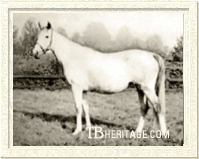
Mah Mahal
| |
MAH MAHAL (gr.f. 1928 by Gainsborough) dead-heated for first once in seven starts at two, and won a minor handicap at Worcester at three. She produced nine foals, led by Epsom Derby winner Mahmoud (gr.c. 1933 by Blenheim II), who stood a couple seasons in France before being sent to Kentucky, where he became a leading sire. Mah Mahal's other foals included Khan Bahadur (c. 1935 by Blenheim II) winner of the Prince of Wales's Stakes and Rous Memorial Stakes; Pherozshah (c. 1934 by Pharos), sire of Rose O'Lynn (dam of Buisson Ardent, Venture VII) before his export to a successful stud career in New Zealand; Golden Fawn (1937 by Bahram), a major stakes winner in India; and Mah Iran (f. 1939 by HREF="Bahram.html">Bahram).
|
|
Mah Iran was the second best two-year-old filly of 1941 and became the dam of Migoli (1944 by Bois Roussel), winner of the Prix de l'Arc de Triomphe, Eclipse Stakes, Champion Stakes, and second in the Derby. Migoli later sired the American Belmont Stakes winner Gallant Man. Migoli's sister, Star of Iran (by Bois Roussel - Mah Iran), produced the great filly Petite Etoile (1956 by Petition), who was inbred 4x5 to Lady Josephine through Mumtaz Mahal and Lady Juror.
|
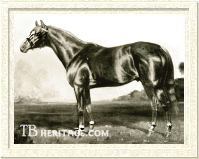
Furrokh Siyar
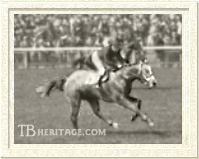
Badruddin
| |
In 1929, Mumtaz Mahal produced FURROKH SIYAR (ch.c. 1929 by Colorado), a minor stakes winner in France (Prix Frisky Matron, Prix de Senailly) over five furlongs, and a good to useful sire of sprinters in Ireland.
Mumtaz Mahal's son BADRUDDIN (gr.c. 1931 by Blandford) was conceived in Ireland but foaled in France. He is described as a useful runner, winner of the Sussex Stakes, Midsummer Stakes, and Waterford Stakes, and third in the 2,000 Guineas. He went to stud in France where his main claim to fame comes as the sire of Perfume II, dam of 2,000 Guineas winner My Babu (sire) and Cambridgeshire Handicap winner Sayani (sire), and the German horse Loliondo. Badruddin was sent to Argentina in 1938 and was a successful sire there, as well.
In 1932, Mumty produced the filly MUMTAZ BEGUM (b.f. 1932 by Blenheim II) who was foaled in France. She won twice at two in England, her only season racing. She was bred at three and had ten foals, eight winners, led by the outstanding colt Nasrullah (1940 by Nearco), obviously the best of his generation, but unable to demonstrate that superiority due to his own quirky temperament. Champion at two when his wins included the Coventry Stakes, he won the Champion Stakes at three and managed third in the Derby. After one season at stud in England, and six in Ireland, Nasrullah was sold to America for the 1951 season. He was a leading sire in England and five times in the U.S., and his sons included Never Say Die, Nashua, Bold Ruler, Never Bend, Bald Eagle, Jaipur, Grey Sovereign, Red God, and numerous others of ability or renown at stud.
|
Mumtaz Begum's other foals included Nasrullah's sister Rivaz (b.f. 1943 by Nearco), who won the Bedford, Queen Mary, and July Stakes at two in an early display of the family speed, but failed to train on and did not race at three. Rivaz produced the good filly Palariva (1953 Palestine), a top two-year-old, and a leading sprinter at three and four; also Molecombe Stakes winner Tayeh, and in the U.S., produced the outstanding filly Spicy Living (by Gallant Man). Palariva became the granddam of Kalamoun.
Mumtaz Begum's daughter Dodoma (1947 by Dastur), was the champion two-year-old filly of her year and produced Diableretta, another precocious wunderkind of memorable speed. Diableretta produced champion filly Ginetta, and through her, became the fourth dam of Shergar. Dodoma also produced Nilo, a leading sire in Australia, who was later sent to the U.S.
Mumtaz Begum's progeny also included the minor stakes winners Darbhanga (1942 by Dastur) and Nizami (1946 by Nearco); Nasrullah's stakes-winning full sister Malinidi (foaled 1947; from which descends the American champion Risen Star); the unplaced filly Sun Princess (1937 by Solario), later the dam of the good stakes winner and sire Royal Charger and his sister Tessa Gillian (ancestress of Klairess and Eight Carat); and Bibibeg (1941 by Bahram), dam of Grounded II.
Although she never raced, Mumtaz Mahal's daughter RUSTOM MAHAL (gr.f. 1934 by Rustom Pasha), showed tremendous ability in training, and was said by jockey Gorden Richards as the fastest filly he ever road. As a broodmare, Rustom Mahal produced a colt to justify that opinion in Abernant (gr.c. 1946 by Owen Tudor), champion at two, and the greatest sprinter in post-war Europe, as well as an important sire.
Mumtaz Mahal's best racing son was MIRZA II (b.c. 1935 by Blenheim II). Bred in France, he was a brilliantly fast two-year-old in the family tradition. His "impelling action and brilliance of his victories at Newmarket roused the enthusiasm of racegoers as few horses have done in modern times." Mirza II was limited to six furlongs, but his trainer, Frank Butters, declared him the fastest horse he had ever handled. He won the Bedford Stakes, Chesterfield Stakes, July Stakes, Chesterfield Stakes, Coventry Stakes and Lavant Stakes, and was second in the Champagne Stakes (by half a length to Portmarnock), and Middle Park Stakes by haed to Scottish Union. He was given the third high weight on the year end Free Handicap for 1937. At three he won the Greenham Plate and was third in the 2,000 Guineas. Mirza II retired to stand in France, and during the German invasion of Normandy in 1940 was seized by the Germans and held until the end of the war in 1946. After that, he was sent to England after the war and sired a few stakes winners including the filly Skylarking II, dam of classic winner Yla II, and ancestress of Rahy, Glorious Song, Saint Ballado, and Devil's Bag.
Mumtaz Mahal's son NIZAMI (c. 1937 by Firdaussi) was not a winner on the track, but was sent to stud in New Zealand, in the footsteps of Pherozshah, and was a useful stallion there.
Mumtaz Mahal's first four foals were bred in England, and she was sent to the Aga Khan's French stud, Haras Marly-la-Ville in Normandy when in foal to Blandford, carrying Badruddin, who was born in France in 1931. During World War II, the stud was taken over by the invading German army in 1940, and most of the mares and stallions were confiscated with the exception of Mumtaz Mahal. The mare was 19 years old at the time, and may have been passed up for her age, although some would like to believe it was out respect for her greatness that she was left behind untouched. Mumtaz Mahal died in February, 1945 at Haras Marly-la-Ville, Oise, France at the age of 24.
Mumtaz Mahal was gone, but the memory of her breathless speed lives on, and has been passed on generously to her many descendants.
-- Anne Peters |
|
|
|

